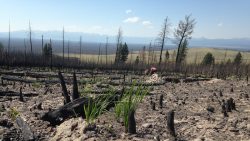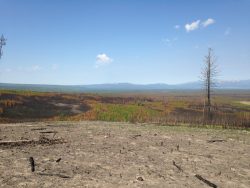
A new study from the University of Washington has found that forest ecosystems may be facing more profound ecological impacts due to wildfires than has previously been documented. The study, published in the journal Global Ecology and Biogeography, shows that as wildfire activity increases with climate change and more forests face multiple wildfires within a short period of time, overlapping fires are changing forest resilience.
“It’s really important to understand the cumulative impacts of multiple successive fires on forest landscapes,” said Brian Harvey, assistant professor in the School of Environmental and Forest Sciences and lead author on the study. “If you only look at each overlapping fire individually, you might be missing a big piece of the story in terms of how they cumulatively shape that landscape.”
When wildfires burn through a forest ecosystem, they don’t do so evenly — some areas may be severely burned, with nearly all vegetation killed, while others are left relatively untouched. The result is a pattern known as a “mosaic,” in which stands of living trees are scattered throughout a burn area after the fire is extinguished. Those remaining live trees are an important source of seeds as the forest begins to recover in areas that were burned severely.
But what the researchers discovered is that when multiple fires overlap within a relatively short period of time — commonly referred to as “reburns” — their burn mosaics can fit together like puzzle pieces, with the second or even third fires often burning severely in some stands of trees that had survived previous fires.

Further, the study found that in reburned forest landscapes, nearly a quarter of areas had burned severely in both fires. “Two or more high-severity fires within just a few decades is a double whammy, because forest resilience in these ecosystems requires more time for trees to establish and be ready for the next fire,” Harvey said. “The forest is going to be a lot slower to recover than if it had reburned and only one of the fires was high-severity.”

These findings have different implications for different types of forest ecosystems. In relatively dry, low-elevation forests, such as the ponderosa pine forests found throughout the western U.S., these burn patterns could actually help reduce the excess vegetation that has built up over the past century of fire exclusion and suppression. That could be a good thing, as forest managers seek to reduce the amount of fuel that feeds large, severe wildfires that are uncharacteristic of these ecosystems.
In cooler subalpine forests and wetter maritime forests such as those on the western slopes of much of the Cascade Range, wildfires have historically been severe, though much less frequent. As fires become more frequent in those ecosystems due to hotter, drier conditions, overlapping burn patterns could reduce the amount of old-growth forest and threaten species that aren’t well adapted to frequent, severe fires.
“It will be important to track how these ecosystems change going forward,” Harvey said. “With each additional reburn, the fuels available for the next fire are changed, and could limit future fire severity. However, increasingly severe weather and climate conditions can sometimes override those limitations. The net outcome is that overlapping wildfires do significantly change the landscape.”
This research was supported by a grant from the National Science Foundation and the US Forest Service, with additional support from the Joint Fire Science Program and the Northwest Climate Adaptation Science Center.
Story by Will Shenton

